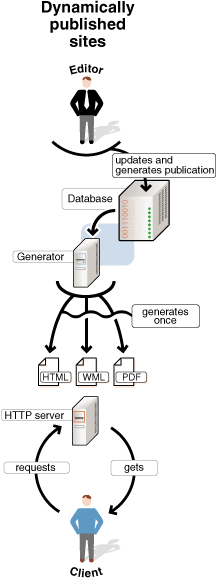|
|
Static, dynamically published and dynamic: 3 web sites generations
|
 |
 Everydeck is the first solution for end users to create and manage an entirely dynamic web site, while most solutions for small businesses feature only the publication of static HTML pages. Everydeck is the first solution for end users to create and manage an entirely dynamic web site, while most solutions for small businesses feature only the publication of static HTML pages. |
 |
|
|
 |
|
Multi-pages version
|
 |
 |
First generation : static web sites
A compromise: dynamically published sites
 |
 |
 |
 |
According to the same survey, 7% of the sites are more evolved. Also made of static pages, they use interfaces more user friendly than an HTML editor, for instance through forms or objects inserted in the page and managed with mini-editors such as word processing or spreadsheets. Static HTML pages are dynamically published: content is published (more exactly, integrated into an existing page) and saved as an HTML file (content is then not saved in a database). Thanks to these interfaces, anyone familiar with graphical interfaces such as MS Windows can update the site, and to a lesser extent modify graphics. This solution has major drawbacks. In the case of an estate agency for instance, contacts details of an employee cannot be dynamically corrected in all the estate ads managed by this employee. Each ad must be corrected by hand. Besides, interactivity with the user is very limited and the visitor cannot intervene. Search and profiling functionality are more than basic. Lastly, in most cases, to opt for a new graphical template is not possible once the site has been published.
| Dynamic publication |
 |
| Publication mode |
Publication of static pages |
 |
| Publication format |
HTML, WML, etc. (independent from each other) |
 |
| Content management |
None |
 |
| Update frequency |
Low to medium |
 |
| Design evolution |
By non specialists (through integrated style sheets) |
 |
| Interactivity |
Through additional interactive modules (polls, forums ; etc.) |
 |
| Use |
First generation shop window site, but easier management |
 |
|
 |
Second generation web sites: dynamic web sites
|
 |
|
|
|
